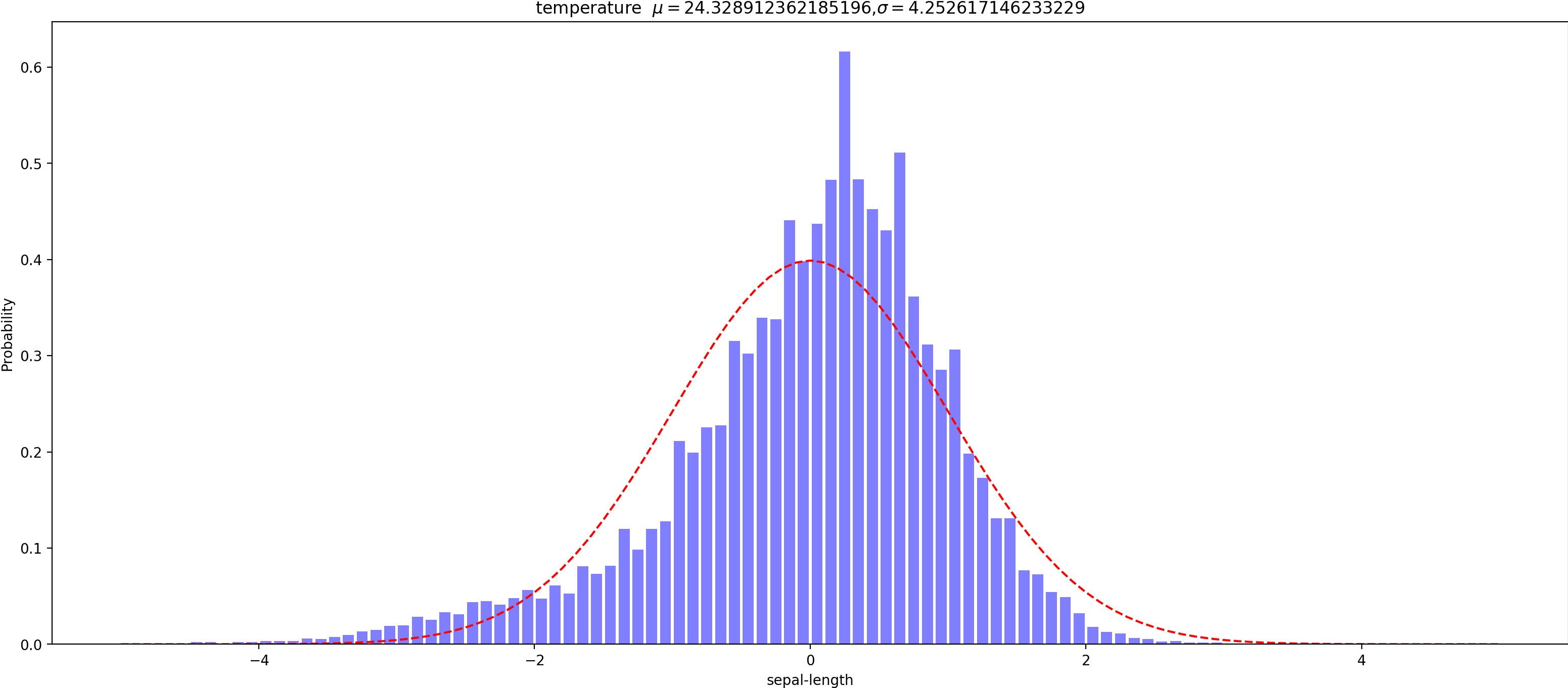def normfun(self, x, mu, sigma): """ 正态分布的概率密度函数 :param x: 数据集中的某一具体测量值 :param mu: 数据集的平均值,反映测量值分布的集中趋势 :param sigma: 数据集的标准差,反映测量值分布的分散程度 :return: """ pdf = np.exp(-((x - mu) ** 2) / (2 * sigma ** 2)) / (sigma * np.sqrt(2 * np.pi)) return pdf
def draw(self, name, data): mean = np.mean(data) # 计算均值 std = np.std(data) # 计算方差 data1 = [(x-mean)/std for x in data] # z-score标准化方法(数据标准化) num_bins = 100 # 直方图柱子的数量 plt.figure(figsize=(20, 8)) # data数据 num_bins柱子个数 range取值范围[-3.3] rwidth柱子宽度 n, bins, patches = plt.hist(data1, num_bins, range=[-5, 5], rwidth=0.8, density=0.9, facecolor='blue', alpha=0.5) # 直方图函数,x为x轴的值,density=1表示为概率密度,即和为一,绿色方块,色深参数0.5.返回n个概率,直方块左边线的x值,及各个方块对象 # print(bins) y = self.normfun(bins, np.mean(data1), np.std(data1)) # 拟合一条最佳正态分布曲线(方程)y 代替品 ——>>> from scipy.stats import norm y = norm.pdf(bins, mu, sigma) plt.plot(bins, y, 'r--') # 绘制y的曲线 plt.xlabel('sepal-length') # 绘制x轴 plt.ylabel('Probability') # 绘制y轴 plt.title(r'{} $mu={}$,$sigma={}$'.format(name, mean, std)) # 标题 plt.subplots_adjust(left=0.15) # 左边距 out_file = 'out_pic/%s.png' % name plt.savefig(out_file, transparent=True, bbox_inches='tight', dpi=200, pad_inches=0.0, set_visiable=False, format='png') print('画图完成 %s' % out_file) # plt.show()

| 属性 | 说明 | 类型 |
|---|---|---|
| x | 数据 | 数值类型 |
| bins | 条形数 | int |
| color | 颜色 | "r","g","y","c" |
| density | 是否以密度的形式显示 | bool |
| range | x轴的范围 | 数值元组(起,终) |
| bottom | y轴的起始位置 | 数值类型 |
| histtype | 线条的类型 | "bar":方形,"barstacked":柱形, "step":"未填充线条" "stepfilled":"填充线条" |
| align | 对齐方式 | "left":左,"mid":中间,"right":右 |
| orientation | orientation | "horizontal":水平,"vertical":垂直 |
| log | 单位是否以科学计术法 | bool |